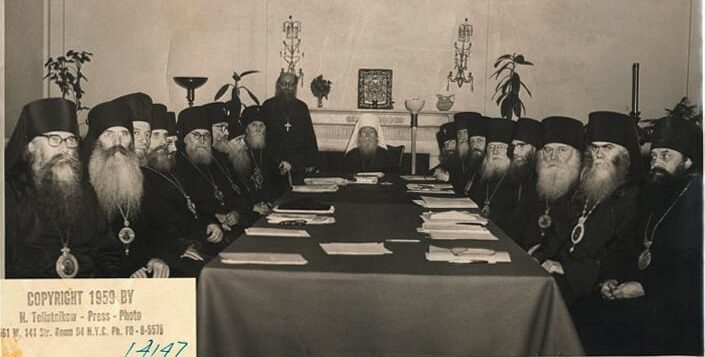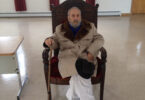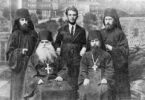Those who knew Metropolitan Anastasii marveled at his consistent composure during the confusion of World War II and the following years of division in the Church. His singlemindedness prompted one writer to observe that if he “had wavered and doubted, then the horrible would have occurred: the plan of diabolic forces [atheistic Communism] would have triumphed… Let us bow down to the ground before our Primate, Metropolitan Anastasii, for having chosen between the difficult truth, abandoned by all, and the untruth, arrayed in the most attractive robes and supported by all.” [1] Orthodox Life, (May/June 1965).
By 1950, a majority of Russian Emigres were living in the Americas, and it was clear that headquarters for the Russian Church Outside Russia should now be moved to the New World. As one of the largest and most important cities in the world, New York was selected. A benefactor, Sergei Semenenko, gave the Synod a handsome building on 93rd Street, near Central Park. This enormous, historic, nineteenth-century brick mansion became the worldwide administrative center for the Church Abroad — “our common home.” [2] Orthodox Life, (May/June 1986).
The floor plan of the mansion was U-shaped, with a large courtyard facing the street and giving entry to a ballroom of noble proportions, with wood parquet floors and crystal chandeliers. This spacious room was easily converted into the Cathedral of Our Lady of the Sign and became the episcopal seat of the First Hierarch of the exiled Russian Church. Elsewhere in the building, a chapel the size of a small parish church was dedicated to St. Sergius of Radonezh, and used for daily services. Two schools, administrative offices, a library and archives, apartments for cathedral clergy, large rooms for Synod meetings, and a special suite that served as the official residence of the Metropolitan were all provided for in the same structure. With its sweeping marble staircase, wood-paneled rooms with fireplaces, and large, heavy-framed oil portraits of various prelates, the mansion has served as a fitting setting for most major events in the liturgical and administrative life of the Church Abroad. The Department of Public and Foreign Relations for the Synod was also located here, under the direction of Count George Grabbe (who was an archpriest by the 1950s). This department was to handle all questions of an inter-jurisdictional nature, and in the 1960s and 1970s would be instrumental in forging the Church’s policy concerning the Ecumenical Movement.
The transfer of headquarters to New York had an immediately vivifying effect on the Church Abroad. “New churches and parishes began to open where before there had been only newly-arrived refugees from Europe and Asia. Metropolitan Anastasii’s visits to various cities after his arrival in America were real holidays for these places; the Russian Church Outside of Russia became consolidated and flourished. Thanks to these and later visits, the Metropolitan established an active bond with his flock.” [3] Orthodox Word, (July/August 1965).
One of his first major acts was to consecrate the main church at Holy Trinity Monastery in upstate New York, near the hamlet of Jordanville. As a result of the humble labors of a few Russian monks, this monastery — soon to become a veritable “Little Russia” — had already been in existence for some years. A center not only of monastic life, Holy Trinity soon established a seminary for future priests of the Church Abroad, and today, nearly one hundred men — monks and seminarians — live, pray, study, and work in the peaceful countryside setting of this monastery. A center of Slavic studies, its main church is an architectural jewel straight out of old Russia, an object of pilgrimage by Orthodox Christians of many jurisdictions, as well as non-Orthodox inquirers into the Faith.
At this time, Metropolitan Anastasii also performed the rare and lengthy series of rites required for consecrating Holy Chrism — the sacred oil used after baptism in the Sacrament of Chrismation. The Orthodox custom is for the supply of Chrism for all dioceses to be consecrated in large amounts, as needed, by the patriarch or metropolitan of each autocephalous Church. Thus, the last Chrism for the Russian Church had been consecrated by Patriarch Tikhon and a sufficient supply had been taken into exile. After more than thirty years, the supply had been depleted, and so Anastasii performed this historic rite — another way of inaugurating a new period in the history of the Church Outside Russia.
Under Metropolitan Anastasii, sobors or the Church Abroad were attended not only by North and South American bishops, but also by those in Europe and Australia (most of the Church in China had evacuated to Australia and the United States at the beginning of Mao Tse-Tung’s anti-religious dictatorship in 1949). These sobors were convened in 1953, 1956, 1959, and 1962. The Sobor of 1956 also marked Anastasii’s golden jubilee as bishop — in itself a rare event in the history of the Russian Church.
The Sobor of 1959 was typical in that the assembled bishops (sixteen on that occasion — eight from North America, eight from abroad) restated their position regarding the Church in the Soviet Union: “We comprise one family with our suffering brethren, now being oppressed by the persecuting godless Soviet power. We all are the sons of multitudinous races, yet one Russian people of undivided Orthodox Russia… firmly united by one faith, and now by mutual suffering.” Calling the emigres to “renew yourselves spiritually,” the bishops also challenged those under the Soviet yoke to “be daring, children [and] cry out with all your hearts and from the depths of your soul, [so that the Lord] shall save you from the enslavement of the enemy’s hands.” [4] Orthodox Life, (November/December 1959).
The parameters of the American schism were now settled, the lines clearly are drawn. Although there continued to appeal to the Metropolia to rejoin the Russian Church Abroad, attention was now focused more and more on the reality of life in American society — so dramatically different from that of Russia or even Europe. Metropolitan Anastasii was particularly concerned about missionary activity, and proclaimed this interest in a pastoral instruction to the bishops at the Sobor of 1959:
“There stands before us the very important problem of missionary activity — and we must show ourselves to be worthy and be zealous in its promotion, asking the Lord to give us wisdom with His grace.” [5] Ibid.
It was not from flattery that his brother bishops called Anastasii “Most Wise,” but because he “expressed his opinion always with great circumspection, weighing everything precisely, never having recourse to extremes. In everything he knew moderation.” [6] Orthodox Word, (July/August 1965). In short, he was an ideal ruler for the Church at a time of transition and steady growth.
But at the beginning of Lent in 1963, Anastasii fell seriously ill and was hospitalized for a short time. Although mentally alert, his physical health began to fail; he was, after all, already over ninety years old. By January 1964, he decided to retire and wished, as had Metropolitan Antonii before him, to preside over the selection of his successor. Accordingly, in May 1964, a sobor of bishops from around the world selected the youngest in seniority of the number — their “Benjamin” — Philaret (Voznesenskii), who had been consecrated bishop of Brisbane, Australia, only the year before. The assembled hierarchs also elected Metropolitan Anastasii “Honorary President of the Council and Synod of Bishops,” and bestowed upon him the title “Most Blessed,” with the right to wear two panagias.
Shortly thereafter, the enthronement of the Metropolitan Philaret took place. It was unusual in that the ancient text for the enthroning of a metropolitan of Moscow was used. This striking service had been uncovered through the zealous research of a graduate of Holy Trinity Seminary, Dimitrii Alexandrov, who was much later to be part of historic restoration of the episcopacy in the Old Rite (see Chapter Ten). An eyewitness account of Metropolitan Philaret’s enthroning made clear the appropriateness of using the venerable Muscovite rite:
“Thus, by the grace of God, our humble Church in Exile was especially called upon to feel herself [as] the very same Russian Orthodox Church of old… In the continuing act of enthronisation, the consciousness in the faithful of being the church received incarnation.
All experienced quite an exceptional lifting of the spirit when…the whole church was suddenly plunged into a sea of lights, the Royal Gates swung open and Metropolitan Philaret emerged, arrayed in the usual bishop’s violet mantle and a black cowl with its diamond cross. All the bishops disposed themselves in a semi-circle on either side of him. The Metropolitan’s blue mantle was brought out by Archbishop John; Archbishop Aleksandr carried the Metropolitan’s white cowl on a salver. (Both mantle and cowl had just then been consecrated in the altar by Metropolitan Anastasii)…”Axios! ” [“Worthy!”] was the cry of all the bishops and clergy. “Axios!” thundered the two choirs in succession… Unassumingly, calmly, naturally, and with confident simplicity was each expected movement executed and each word delivered by [Philaret], and this only increased the ineffable majesty of what was taking place. For it was not only that the youngest among the bishops was being suddenly elevated to the highest position… but this very height received a new meaning, opening up for us perspectives which only yesterday seemed to have been antiquated.” [7] Orthodox Life, (May/June 1964).
In the next months, Metropolitan Anastasii began to prepare himself for death. Remaining secluded in his rooms and “entering completely into his inner life”, [8] Orthodox Word, (July/August 1965). he listened to Divine Services every day by means of an amplifier, receiving Holy Communion almost daily. On May 22, 1965, this “Most Wise” and “Most Blessed” one departed this life. While he lay in state at the Synod Cathedral in New York, representatives from many churches, including non-Orthodox ones, came to pay their respects, and the funeral services were attended by representatives of the Greek Archdiocese, the Patriarchates of Constantinople and Serbia, and the Greek Old Calendar Church. Following the funeral, an enormous cortege took his remains to Holy Trinity Monastery near Jordanville where, after another requiem, Metropolitan Anastasii was entombed in a special crypt at the back of the main church. Thus did “the Risen Christ receive into His Kingdom His servant who bore the name of Resurrection [which is the meaning of “Anastasii” in Greek].” [9] Ibid.
Only then was his last will and testament made public. A simple document, in which the great prelate asked forgiveness of all those he has offended, and thanked all “who have been good to me in any way, or who may have only had the wish and intention to do so but did not implement this decision owing to circumstances beyond their control,” he gave the following advice to the prelates who survived him:
“As regards to the Moscow Patriarchate and its hierarchs, then, so long as they continue in close, active and benevolent cooperation with the Soviet Government, which openly professes its complete godlessness and strives to implant atheism in the entire Russian nation, then the Church Abroad, maintaining her purity, must not have any canonical, liturgical, or even simply external communion with them whatsoever, leaving each one of them at the same time to the final judgment of the Sobor of the future free Russian Church.” [10] Orthodox Life, (May/June 1965).
“The key to Metropolitan Anastasii’s life,” wrote one observer, “lies in his simple rule, available to all, yet alas, observed by so few: never, under any circumstances [to] act contrary to the voice of his conscience, that voice of God within us… This firm and unbending loyalty to the dictates of God’s inner voice gained for Metropolitan Anastasii such enormous moral authority that often even his enemies had to bow before it.” [11] Ibid. This singlemindedness originated in a spiritual experience Anastasii had as a teenager, which he made reference to in his testament:
“At the age of fifteen, I felt especially deeply the insignificance of all that is earthly, began to avoid people, became pensive and cooled toward not only all the joys of life, but also toward life itself, considering that all was nothing compared to eternity.” [12] Ibid.
This, then, was the powerful source of Anastasii’s inner serenity in the face of great trials and challenges, an equanimity the Church would need more than ever in the years to come.
References
| ↵1 | Orthodox Life, (May/June 1965). |
|---|---|
| ↵2 | Orthodox Life, (May/June 1986). |
| ↵3 | Orthodox Word, (July/August 1965). |
| ↵4 | Orthodox Life, (November/December 1959). |
| ↵5 | Ibid. |
| ↵6 | Orthodox Word, (July/August 1965). |
| ↵7 | Orthodox Life, (May/June 1964). |
| ↵8 | Orthodox Word, (July/August 1965). |
| ↵9 | Ibid. |
| ↵10 | Orthodox Life, (May/June 1965). |
| ↵11 | Ibid. |
| ↵12 | Ibid. |












This is the first time I am reading this. There are a couple of points I would disagree with (only reading a few chapters): Bp. Philaret almost assuredly did not have a cross on his black klobuk when he came out to be made a metropolitan; and I have always heard that the election of Metr. Vitaly, described in another chapter, took place differently, with Metr. Hilarion not disagreeing with the version I heard… I’m still reading…